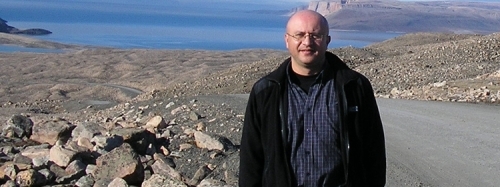A 50th Anniversary; Rocket Interceptors; Buy American & Blue Streak
 |
| Hugh Dryden and Herbert Ribner in February 1959. |
The general confusion during the late 1950s about the merits of missile defence led to several questionable strategic decisions made by the Governments of Canada and the United Kingdom.
The possibility of a third contestant in the Space Race, in the form of a Commonwealth space program hinged on the sharing of technology and financing amongst the various invested nations, but more significantly on the political choices made regarding the future defensive postures of Canada, the United States and the United Kingdom.Just three days after the termination of the Avro Arrow interceptor program James C. Floyd, chief engineer for the cancelled aircraft, was scheduled to speak in Montreal at a Canadian Aeronautical Institute conference. The event was to celebrate the 50th anniversary of flight in the Commonwealth. Floyd was supposed to chair the Space Flight session where he would introduce Hugh Dryden (Deputy Administrator of the brand-new American National Aeronautics and Space Agency) who had come to Canada to explain the workings of the American space program.
 Dryden was considered to be one of the world's top aeronautics experts, and in 1954 he had chaired a hearing between the Canadian National Research Council (NRC) and the management of A.V. Roe. The NRC had questioned Avro's performance predictions for the Arrow and had been quietly put in their place by Dryden who stated that Floyd's numbers were probably conservative and that as far as he was concerned the Avro team had no peers anywhere in the world. Not surprisingly Floyd didn't appear at the dinner in Montreal due to the chaos back at Avro, a sad irony almost certainly not lost on Dryden.
Dryden was considered to be one of the world's top aeronautics experts, and in 1954 he had chaired a hearing between the Canadian National Research Council (NRC) and the management of A.V. Roe. The NRC had questioned Avro's performance predictions for the Arrow and had been quietly put in their place by Dryden who stated that Floyd's numbers were probably conservative and that as far as he was concerned the Avro team had no peers anywhere in the world. Not surprisingly Floyd didn't appear at the dinner in Montreal due to the chaos back at Avro, a sad irony almost certainly not lost on Dryden.With Floyd unavailable the position of host fell to Dr Herbert Ribner.[1] Born in 1913 in Washington Ribner had been an acclaimed aerodynamicist at the National Advisory Committee for Aeronautics before moving to Canada and taking a position at the University of Toronto.[2] Dryden had been Ribner's boss at the NACA all through the late 1940s.
Ribner shared the chairmanship of the Canadian Aeronautical Institute's Astronautics Division with David Bogdanoff, a fellow American from Michigan who was head of the rocket research arm of Canadair and had played a major role in the Velvet Glove program. At the event Dryden made a dazzling presentation of American space assets showing the enormous array of projects in progress at that time.[3]
Solid Fueled Rocket Intercepters
The very next day Canada's largest rocket program began. The first firing of the new Canadian propellant took place on February 24th 1959 at the CARDE facility in Valcartier Quebec. The burn would output 20,000 pounds of thrust for 20 seconds, which was about 25% better than the standard Skylark.[4] Black Brant would be launched for the first time seven months later, on September 5th 1959, at the USAF-operated Churchill Rocket Range facility in Manitoba Canada.
Despite its military origins and funding Black Brant would never become an interceptor...

To Continue Reading Part 3 of
"The Empire Strikes Out - Canada's Defence & The Commonwealth Space Program"
Your $5.00 CDN monthly subscription will help to support both the Space Library and
the Commercial Space blog.
 |
| Robert Godwin. |
He has written or edited over 100 books including the award winning series "The NASA Mission Reports" and appeared on dozens of radio and television programs in Canada, the USA and England as an expert not only on space exploration but also on music.
His books have been discussed on CNN, the CBC, the BBC and CBS 60 Minutes. He produced the first ever virtual reality panoramas of the Apollo lunar surface photography and the first multi-camera angle movie of the Apollo 11 moonwalk. His latest book was written with the late Frederick I Ordway III and is called "2001 The Heritage and Legacy of the Space Odyssey" about the history of spaceflight at the movies.
Footnotes
1. Canadian Aeronautical Journal Apr 1959.2. Graduate of Cal Tech, NACA alumni, Professor at the University of Toronto and Chairman of the Canadian Aeronautical Institute's Astronautics section
3. Recent Trends in Aeronautics and Space Research in the United States - Hugh Dryden - CAI Journal October 1959
4. Globe and Mail Feb 25 1959
Last Week: "Cancelling the Arrow; A Government Not Interested in Space; Sounding Rockets,
the Black Brant & Velvet Glove," in part two of "The Empire Strikes Out - Canada's Defence & The Commonwealth Space Program."
Next Week: "Britain follows Canada's Lead; Rearming the RCAF and the Commonwealth Space Symposium," as part four of "The Empire Strikes Out - Canada's Defence & The Commonwealth Space Program" continues!
the Black Brant & Velvet Glove," in part two of "The Empire Strikes Out - Canada's Defence & The Commonwealth Space Program."
Next Week: "Britain follows Canada's Lead; Rearming the RCAF and the Commonwealth Space Symposium," as part four of "The Empire Strikes Out - Canada's Defence & The Commonwealth Space Program" continues!




























